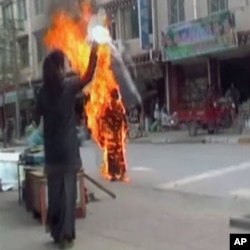Since last March, at least 16 Tibetans, mostly monks and nuns, have set themselves on fire in protest of Chinese government policies.
Although initially these self-immolations were largely isolated to a Tibetan area in southwestern China, they have spread and grown in number. Between March and the end of September last year, four Tibetans set themselves on fire in protest. From October until the end of last month, another 12 followed in their footsteps. Four occurred in January alone.
Very few of these self destructive acts have been caught on camera, but one self-immolation that has made it to the outside world was that of Palden Choetso, a nun from a Tibetan area in southwestern China’s Sichuan province. In the video, she stands as the flames engulf her body and she later falls to the ground.
Palden Choetso set herself on fire in November and was the 11th Tibetan to resort to this extreme form of protest.
Robbie Barnett, a Tibet specialist at Columbia University in New York, says that as the number of self-immolations grows and spreads to more areas, Tibetan patience in China appears to be running out.
"There is more nationalism in these Tibetan areas than there was probably at any time in history. And this has come probably as a result of bad Chinese policies that have gotten more tough and more aggressive in the last 15 years especially."
The wave of self-immolations during the past year began in March, when a 20-year-old monk Phuntsong set himself on fire to mark the third anniversary of a bloody Chinese crackdown on protests at the Kirti monastery in Aba.
But Phuntsong's self-immolation was not the first. The precedent for this form of protest was set in February 2009, when a monk from the same monastery set himself on fire.
The Washington-based International Campaign for Tibet says that monk, named Tapey, self-immolated after local authorities banned monks at the monastery from observing a traditional prayer festival during the Tibetan New Year. During the past year, six of the first eight self-immolations were carried out by Kirti monks, but gradually the incidents have spread.
Exiled Tibetans in Dharmsala, India, carry portraits of Palden Choetso, a 35-year-old Tibetan Buddhist nun who set herself ablaze in 2011. (AP)
Steve Marshall, a senior advisor for the U.S. Congressional-Executive Commission on China, has spent more than two decades researching human rights violations in Tibet.
"What we’re having as these immolations move out, we are having precedents set in more and more counties," Marshall said. "We're seeing precedents established for self-immolation and this is something Tibetans are going to remember for a long, long time."
China has tightened security in Tibetan areas where the immolations have occurred and branded those who burn themselves to death as terrorists.
Beijing also has accused Tibet's exiled spiritual leader, the Dalai Lama, of supporting the acts, an accusation the Dalai Lama and the Tibetan government in exile deny.
The head of the Tibetan government-in-exile, Lobsang Sangay, says his administration does not encourage any form of protest in China because of the consequences of such actions.
"If you protest in Tibet, more often than not you get arrested or beaten up, sometimes tortured. Sometimes you disappear; sometimes you die."
Acts such as self-immolation, Lobsang and analysts say, show how desperate Tibetans in China have become.
In Aba and other Tibetan areas, an increase in religious regulations in recent years has put more pressure on monks and nuns, micromanaging their lives and limiting their freedom of movement, says Steve Marshall of the U.S. Congressional-Executive Commission on China.
"These get down to a level of detail [such as] what kind of a ringtone should you have on your phone, what TV programs can you see, can you have a picture of the Dalai Lama. Very, very petty details about daily life for monks and nuns. More importantly, they control things like can you go anywhere else to hear religious teaching. And if you do go somewhere else, you will have to have permission."
Columbia University's Robbie Barnett says self-immolations also mark a departure from the past, when the situation in Tibet was largely protested by exiles and the Dalai Lama.
"The immolations are marking a very important change, where what is going to happen for the future in Tibet is going to be decided by the decisions of the people inside Tibet," Barnett said. "And these immolations are a very visible, very tragic kind of decision, but they are a political statement."
It is unlikely, analysts say, that protests against Chinese policies in Tibetan areas and self-immolations will end any time soon, especially when the Beijing government's response so far has been to increase security and the repression of human rights.













